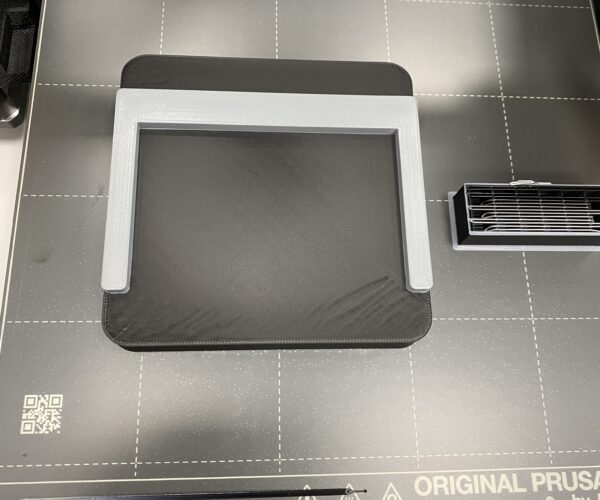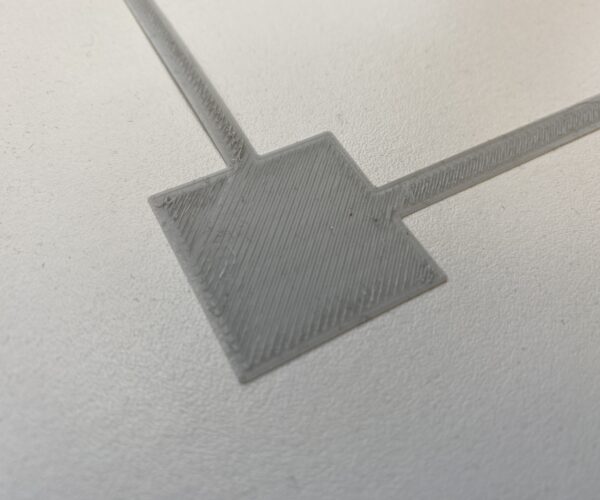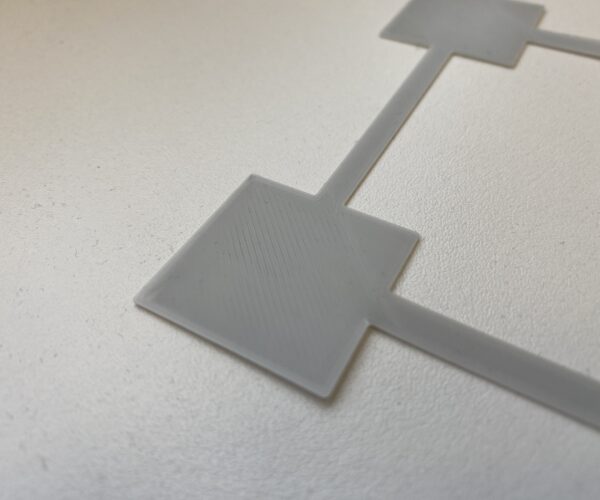Over-extrusion Top-Layer or other Artefact?
When I print with my new MK4S MMU3 combi, I get this wierd over-extrusion or other artefact on top layers. Strange, that not all top layer is affected. One side its clearly visible, the other side is beginning to show signs of over-extrusion. All arround the part in the last 3-5 layers a lip has formed, that could also show a sign of over-extrusion?!
Does someone have an idea, what my problem could be?
Thank you.
From the side, Lip is visible:
Gradient on the surface, middle seems to be unaffected
Closeup on the failing area:
overview:
You have some warping. Clean your print sheet, dishwashing detergent (Dawn/Fairy) and plenty of HOT water. Make sure you are not printing in a draft.
Cheero,
RE: Over-extrusion Top-Layer or other Artefact?
Thanks for the quick response, Diem.
I cleaned the bed as described and put the printer in an enclosure. Same model, same problem.
I have an old Ultimaker 3 where I had to apply glue for better adhesion.
My Anycubic Kobra 2 Pro at home has a rough PEI build plate. I never had to worry about any bed adhesion with it.
Now after my first prints with the MK4S i have not one successful print. A Brim might help, but from now on printing only with Brim is a pain.
Are there other solutions, I could try?
Some improvement but not enough - please show us the underside of that last print.
Cheerio.
RE: Over-extrusion Top-Layer or other Artefact?
I just printed a simple first layer bed level test. Bed is level, but the Z offset seems to be to low. can't find the settings to change it tho.
If the first layer of a print counts that much, does it affect my problem as well? 

RE: Over-extrusion Top-Layer or other Artefact?
A different file for bed level test in gray shows my untrained eye, that the nozzle is a bit to low. The underside shows trapped air pockets between the lines. I can feel these pockets with my fingernail.
Still some loss of adhesion, let's try a more drastic clean. (Sc)rub neat dishwashing detergent into the surface of the print sheet, leave for five minutes, then rinse clean with *VERY HOT* water. Dry with a fresh paper towel handling by the edges only and finish drying by placing on the heated bed ... We normally assume the contaminents are human fingerprints, filament residue and PEI oxidants but if you are using aerosols in the same room, or spraying paint, laying fibreglass, arc welding - anything that creates dust, smoke, spray. You get the idea. The bed needs to be clean.
If the first layer looks too low you can try raising the live Z offset from the LCD menu while watching it go down and see if it helps.
Cheerio,
RE: Over-extrusion Top-Layer or other Artefact?
Thanks for your reply.
I couldn't find the Z offset settings on my MK4S, but after some searching I found the setting in the Slicer under Printer and raised it +0.05mm.The first layer looks better now.
You may not be so wrong about the a aerosols. I'll try the deep clean method as soon as possible. The printer arrived before the enclosure was finished. So it sat in a corner of a larger room with a large CNC mill and lathe for a few days. (coolant, etc.)
You seem to be a fan of dish soap 🙂 Would you substitute it with isopropanol?
Cheers Tobias
RE: Over-extrusion Top-Layer or other Artefact?
- Hi Tobias
Isopropyl Alcohol, is a solvent that dissolves certain substances, so when it comes across grease, it 'thins' the grease and spreads it across a larger area, more evenly...
which may make matters worse...
Obviously some of the grease will transfer to the cloth or tissue that you use to rub the IPA into the build plate in order to clean it, however some grease will remain on the build plate and the IPA will evaporate leaving the grease behind,You can use several applications of IPA to repeatedly thin the grease layer down... but most people don't do that with enough clean fabric to fully remove the contaminant. IPA is relatively expensive and possibly in short supply.
dish soap and hot water are generally plentiful and inexpensive,
Dish soap has been specifically designed to remove contaminants, and uses a different process to IPA.I borrowed the information below from https://ipproducts.com/comprehensive-guide-to-dish-soap/
The Common Ingredients in Dish Soap
Dish soaps are typically made up of surfactants, which are compounds that lower the surface tension between two liquids or a liquid and a solid. Surfactants are the primary cleaning agents in dish soap, responsible for its grease-fighting power.
unlike IPA, Dish soap Actively removes the grease and contamination and allows it to wash away with the rinsing water.
and we can use significant amounts of water to rinse the dish soap and grease away.
I always use a dedicated 'dish sponge' for cleaning my build plates so that there is no chance of cross contamination from normal dish washing processes.
I also use plain paper towels to dry the build plate in preference to cloth, because cloths are often washed with 'softeners' to make them feel nice... and softeners can also prevent adhesion.
Dish soap is more active in hot water, hot water cannot get hot enough to damage build plates... PC Blend for instance prints at 110C to 115C, whilst water boils at 100C (or less at higher altitudes)Drying immediately after washing prevents moisture damage to build plates...
about 6 years ago, (before I found out about Dish soap), I used Acetone to rejuvenate a smooth PEI Build plate... the acetone damaged the PEI and caused it to crack like crazy paving... I have never used Acetone for bed cleaning since then.
many 3d Printers have been surprised by the way dish soap works...
BUT. don't use posh 'Antibacterial' dish soap, because this leaves an antibacterial film on the surface of what ever you wash. Just use basic Dawn, or Fairy or whatever cheap dish soap you can access...
I try to make safe suggestions,You should understand the context and ensure you are happy that they are safe before attempting to apply my suggestions, what you do, is YOUR responsibility.Location Halifax UK










